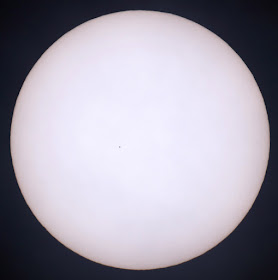Today there was a rare astronomical event - the transit of the planet Mercury across the face of the sun. This is an event that is relatively rare. The last four transits occurred on May 7, 2003, November 8, 2006, May 9, 2016, and November 11, 2019. The next will occur on November 13, 2032. Fortunately, the weather was clear enough to see the transit, which lasts seven hours and thirty minutes. I got to see about one hour of it, before the clouds moved in. What is all the fuss about? It is about the tiny black dot in the center of the sun - the large white ball. The tiny dot is the planet Mercury. Look how small it is! Hardly exciting to see a small dot on the sun, is it? Please click on the image to enlarge it, and you will be able to see Mercury more easily.
In contrast, this is my photograph of the transit of Venus, in 2004. Venus is almost the size of the Earth, and it is much more visible as it crosses the Sun. I was also lucky that there were clouds, which makes for a pretty spectacular photograph, don't you think?


I am very happy you captured this rare event and I especially love the very cool second photo! I had read about mercury passing the sun last week but figured my cheapo August 2017 Solar Eclipse sunglasses and ten-power binoculars wouldn't provide a very stunning celestial experience. Well done!
ReplyDeleteThe patience of an astronomer with the right equipment. Mercury is so tiny in comparison. I especially love the second photo of Venus passing. Lovely colors.
ReplyDeleteJoan
Primo: Mercury is such a small dot crossing the sun, that you would not have been able to see it with binoculars. They say you would need about 24 power magnification to see it.
ReplyDeleteThe size difference between the sun and the planets is amazing and your photos do a great of showing this. The bottom photo is stunning. Trace
ReplyDeleteSo glad you got the shot!! Incredible since it's such a tiny dot against the sun. Your second photo is gorgeous. betsey
ReplyDelete